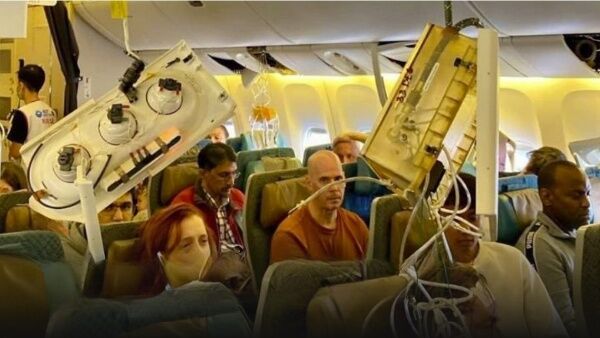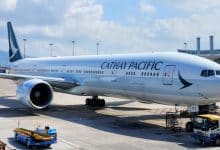Singapore Airlines pays out after turbulence tragedy

Singapore Airlines has offered compensation to passengers following a terrifying turbulence incident that left one dead and many injured.
Singapore Airlines announced it will provide US$10,000 (approximately 360,000 baht) in compensation to passengers who sustained injuries during a severe turbulence incident on a flight from London to Singapore. The tragic episode, which occurred last month, left a 73 year old British man dead and several others with serious injuries, including skull, brain, and spine damage.
The dramatic ordeal unfolded on flight SQ321, a Boeing 777-300ER carrying 211 passengers and 18 crew members. The plane was diverted to Bangkok, where the injured were rushed to local hospitals.
In a statement released today, Singapore Airlines detailed its compensation plan.
“We have sent emails offering US$10,000 to passengers with minor injuries. For those more severely hurt, we have invited them to discuss tailored compensation offers when they are ready.”
Additionally, passengers needing long-term care can request an advance payment of US$25,000 to address immediate medical needs, which will be included in the final compensation package.
The airline also confirmed it would refund the airfare for all passengers on the flight, regardless of injury status, and provide delay compensation as per EU and UK regulations. Under the Montreal Convention, airlines are accountable for damages related to passenger injury or death while onboard.
Initially, Singapore Airlines had given 1,000 Singapore Dollars (approximately 27,000 baht) to each passenger departing Bangkok to cover immediate expenses. The airline has been covering medical costs and arranging for family members of the injured to travel to Bangkok.
“SIA remains committed to supporting the affected passengers on SQ321.”
Singapore’s Transport Ministry revealed the aircraft experienced a sudden 54-metre drop in altitude, causing unbelted passengers to be violently thrown around the cabin. The rapid change in gravitational force occurred as the plane flew over southern Myanmar, according to a preliminary report by the Transport Safety Investigation Bureau, reported Thai PBS World.
The investigation team includes experts from Singapore’s TSIB, the US National Transportation Safety Board, the Federal Aviation Administration, and Boeing.
UPDATE: Eight-figure payouts loom for Singapore Airlines injured passengers
Passengers with severe injuries from the terrifying Singapore Airlines flight turbulence could be in line for eight-figure compensation, says top lawyer.
Following the extreme turbulence encountered by Singapore Airlines Flight SQ321 this week, passengers with spinal and brain injuries might seek massive payouts, with one legal expert suggesting claims could reach easily into seven and sometimes eight-figure sums.
Peter Neenan, a partner at London-based law firm Stewarts, specialising in aviation litigation, explained that previous cases with similarly severe injuries have resulted in substantial compensation.
“The extent of the injuries makes it clear that significant claims are likely.”
Doctors in Bangkok have reported that several dozen passengers suffered traumatic, potentially life-altering injuries. Twenty-two patients are being treated for spinal and spinal cord injuries at Samitivej Srinakarin Hospital, with some showing signs of paralysis, though it’s unclear if it will be permanent.
Additionally, six passengers are being treated for skull and brain trauma. Tragically, a 73 year old Briton died of a suspected heart attack.
Flight SQ321, carrying 229 crew and passengers from London to Singapore, was violently shaken by sudden and extreme turbulence over Myanmar, forcing an emergency landing at Suvarnabhumi Airport in Bangkok on Tuesday afternoon.
Under the Montreal Convention, which governs compensation for international flight incidents, Singapore Airlines is liable for up to US$170,000 (approximately 6 million baht) per person. However, Neenan noted that there is scope for higher damages based on the investigation’s outcome, which could take years.
The investigation will scrutinise flight planning, weather information, and the actions of both passengers and crew during the turbulence. Whether passengers were wearing seatbelts may also be a critical factor.
As of yesterday, 48 people remained in three hospitals in Bangkok, reported Bangkok Post.
In response to the incident, Singapore Airlines announced changes to its procedures: in-flight meal services and hot drinks will be suspended when the seatbelt sign is on, and crew members will secure themselves promptly.
UPDATE: Singapore Airlines overhauls turbulence protocols after fatal flight
Singapore Airlines has swiftly tightened its cabin service rules after a harrowing incident on a flight from London left one passenger dead and many others injured earlier this week.
The airline announced today that it is adopting a more cautious approach to managing turbulence following the sudden altitude drop of Flight SQ321 on Tuesday, which necessitated an emergency landing in Bangkok. The turbulence tragically claimed one life and left dozens hospitalised in Thailand with severe injuries, including spinal cord damage and head trauma.
Under the new protocols, all in-flight meal services will be halted as soon as the seatbelt sign is activated, and hot drinks will no longer be served during turbulence. Additionally, cabin crew members will now be required to secure themselves in their seats during these periods.
Singapore Airlines stated that it will continue to review processes to prioritise the safety of both crew and passengers. However, the policy change does not extend to mandating that all passengers wear seatbelts throughout the flight regardless of conditions, a precaution airlines typically recommend but only enforce during turbulence.
The severity of injuries from Flight SQ321 highlights the immense vertical forces that can act on unbelted passengers during sudden drops. On that fateful flight, individuals were violently thrown into the cabin ceiling, and personal items along with breakfast service equipment were scattered chaotically throughout the aircraft.
According to Samitivej Srinakarin Hospital, 22 passengers have been treated for spinal injuries, six for skull and brain trauma, with 20 in intensive care and 17 undergoing surgery. In the aftermath, over 100 people needed medical attention in Bangkok.
The airline’s statement emphasised that pilots and cabin crew are well aware of the dangers posed by turbulence. Crew members are trained to secure all loose items and equipment to mitigate injury risks.
Turbulence can strike when a plane encounters strong air currents caused by hot air pockets or robust weather systems, and at high altitudes, clear air turbulence, which is difficult to detect, can also pose significant risks, reported Bangkok Post.
Rohan Laging, Deputy Director of Emergency Services at Melbourne’s Alfred Health, compared the violent forces experienced during turbulence to falling headfirst off a ladder or diving into a shallow concrete pool, underscoring the potential dangers.
UPDATE: Singapore turbulent flight: Aussie survivor’s desperate plea
An Australian passenger from the ill-fated Singapore Airlines flight 321 has broken his silence from his Bangkok hospital room.
Keith Davis, previously blocked from speaking to the media, revealed the harrowing details of the flight’s emergency landing in Thailand that left his wife critically injured.
Davis’ wife has been in intensive care since their flight from London to Singapore was diverted after a passenger’s death amid severe turbulence. Speaking with the Today Show, Davis shared the severity of his wife’s condition.
“She has no sensation from her waist down, it’s pretty radical for us.
“We’ve had a fantastic holiday in the UK, we’re one more flight away, nearly home, and this comes along.”
Davis’ wife is undergoing emergency surgery to stabilise her for medical evacuation to their home in Adelaide.
“It was absolute carnage. There was no warning. We just fell into a freefall zone, and before we knew it, we were on the ceiling and then bang, on the ground.”
Davis’ wife fell into the aisle, immobile, as he realised he was bleeding profusely.
Davis lamented the lack of communication from Singapore Airlines.
“I need to know, ‘Am I going through my insurance?’ I’ve got no idea.”
Despite the airline’s heavy presence at Bangkok’s Samitivej Srinakarin Hospital, Davis and his wife received no information initially.
In a bizarre twist, Davis faced a media blackout enforced by hospital staff. In a public cafe within the hospital, staff, joined by security, prevented him from speaking to the ABC’s Bill Birtles. Davis, in a wheelchair with visible facial injuries, attempted to converse over a cup of coffee but was rushed away by staff.
The hospital later apologised, with Dr Adinun Kittiratanapaibool explaining that staff acted with good intentions to protect patient welfare. Singapore Airlines also apologised, committing to support the Davis family during this difficult time and arranging travel for their relatives, reported The Sydney Morning Herald.
Despite these assurances, Davis remains frustrated and hopes for a swift return to Adelaide for further medical treatment.
UPDATE: Passengers recount chaos on ill-fated Singapore Airlines flight (video)
Passengers aboard the ill-fated Singapore Airlines flight recounted harrowing scenes during an emergency landing in Bangkok yesterday, after a 73 year old British man, Geoff Kitchen, succumbed to a suspected heart attack triggered by severe turbulence that wreaked havoc in the cabin.
The turbulence, which struck as a meal service was underway, left more than 30 passengers injured and plunged the flight from London to Singapore into chaos.
British man Andrew Davis described the initial moments of the incident as “awful screaming and what sounded like a thud,” with objects and people being violently thrown around the cabin.
“I was covered in coffee. It was incredibly severe turbulence.”
Dzafran Azmir, a 28 year old student, recounted how the aircraft suddenly “tilted up” and began “shaking” before a dramatic drop caused unbelted passengers to be launched into the ceiling.
“Some people hit their heads on the overhead baggage compartments, denting them and breaking through the areas where lights and masks are stored.”
The Singapore-bound Boeing 777-300ER was forced to divert to Bangkok, making an emergency landing at 3.45pm local time with 211 passengers and 18 crew aboard.
Singapore Airlines reported that 31 passengers were taken to hospital and expressed their deepest condolences to the dead man’s family. The Thornbury Musical Theatre Group in South Gloucestershire, where Kitchen was a respected member, praised him as “a gentleman with the utmost honesty and integrity.”
An airline official explained that about 10 hours into the flight, the plane encountered “sudden extreme turbulence” over Myanmar’s Irrawaddy Basin at 37,000 feet. Singapore Airlines is working with Thai authorities to provide medical assistance and has dispatched a team to Bangkok to support affected passengers.
The nationalities of those on board included 47 passengers from England. Allison Barker shared her anxiety after receiving a message from her son Josh, who was en route to Bali.
“I don’t want to scare you, but I’m on a crazy flight. The plane is making an emergency landing… I love you all.”
She endured a “petrifying” two-hour wait before hearing from him again. Josh, who sustained minor injuries, found himself on the floor after blacking out during the turbulence.
Jerry, a 68 year old British man travelling to Australia for his son’s wedding, recalled the sudden plunge without warning.
“I hit my head on the ceiling, as did my wife. Some poor people doing somersaults.”
Another British passenger, suffering from a neck injury, remarked on their luck.
“It went from no turbulence… no plane shaking at all, and then I was hitting the roof.”
Singapore’s Transport Minister, Chee Hong Tat, expressed his sorrow and pledged government support for the passengers and their families.
“I am deeply saddened to learn about the incident on board Singapore Airlines flight SQ321 from London Heathrow to Singapore.”
Aviation expert John Strickland emphasised the rarity of such severe turbulence despite millions of flights annually.
“However, severe turbulence can be dramatic and lead to severe injuries or, sadly, a fatality.”
He noted the importance of keeping seatbelts loosely fastened throughout flights.
Aviation journalist Sally Gethin underscored that wearing a seatbelt could mean the “difference between life and death” during severe turbulence, warning that anything unsecured is at risk. Research suggests that climate change may increase the frequency of severe turbulence in the future.
ORIGINAL STORY: Singapore Airlines emergency landing claims one life, injures 30
One passenger was tragically killed and 30 others were injured as a Singapore Airlines flight made an emergency landing at Suvarnabhumi International Airport in Bangkok due to the severe weather.
Thai PBS reported that the air traffic control team at Suvarnabhumi Airport received an emergency signal, squawk code 7700, from the Boeing 777-300ER at 4 pm today, May 21. The aircraft en route from London to Singapore requested permission for an emergency landing in Bangkok due to encountering severe weather.
The Facebook page, Pilot Notebook (บันทึกไม่ลับของคนขับเครื่องบิน), later shared that the Singapore Airlines plane encountered with an inclement weather after departing from London and heading to Changi Airport in Singapore.
According to the page, the pilot was compelled to divert the flight’s destination to Suvarnabhumi Airport. Unfortunately, the emergency landing led to the fatality of one passenger and injuries to 30 others. The flight carried 211 passengers and 18 cabin crew, as the South China Morning Post reported.
The report speculated that the incident might have been triggered by unforeseen air turbulence over the Indian Ocean, although the official cause remains unconfirmed. Additionally, it was suggested that the deceased passenger sustained fatal injuries due to not wearing a seatbelt during the landing.
Latest Thailand News
Follow The Thaiger on Google News:


























